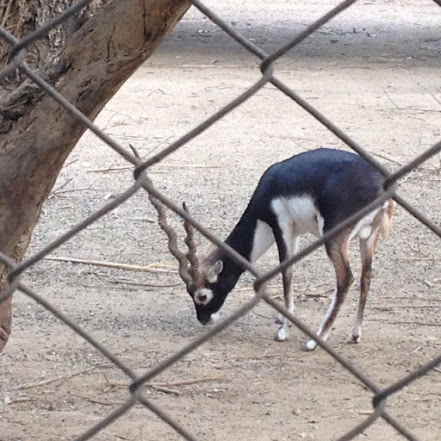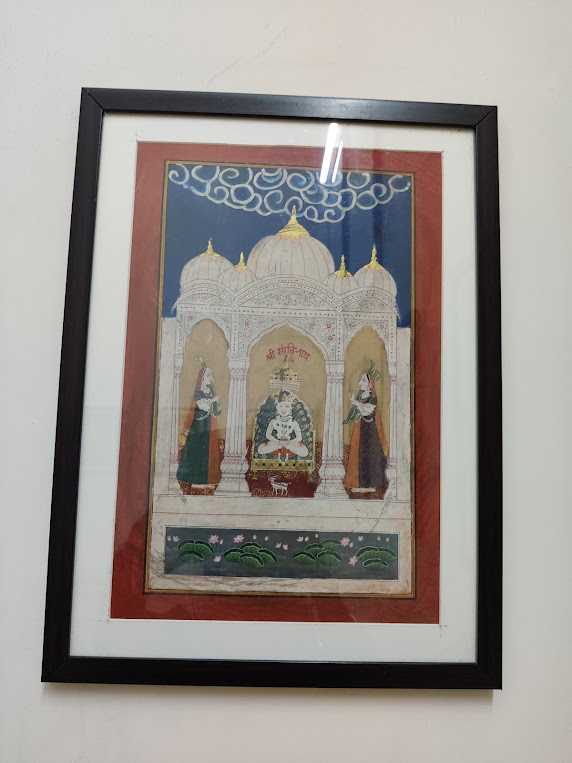Antelope in Indian Mythology
"Where the black antelope ranges by nature, that should be known as the country fit for sacrifices; and beyond it is the country of the barbarians."
Manu Smriti
As per Hindu mythology, the antelope became the first creature to be wounded and the first one to be hunted and sacrificed in order to please the gods. According to the Rig Veda, the universe was created by Prajapati, the Progenitor. He was swayambhu or the "self-existing". As the first self-made divinity, without having any progenitor, he emerged from a golden egg. He, through the means of tapas (spiritual meditational practice), created 33 Rig Vedic gods such as Indra (king of gods), Agni (Fire god), Varuna (Sky god), Surya (Sun god), Vishnu, Pushan, etc. He is also the father of some men like Manu, and Daksha. However, when he created Rig Vedic gods, they left him alone. He returned to his solitude and continued to create. Among many other things, he created death, flies, gadflies, and ashvattha (a fig tree). And then he made Usha. Enamoured by her beauty, he approached her, but she metamorphosized herself into an antelope. He too took the form of an antelope and mated with Usha. The gods who were already enraged by their father, Prajapati for creating mrityu or death, found an opportunity to take revenge from the father. They came together and combined their energies to create Rudra, the Archer. Rudra with his bow and arrow went after Prajapati and while he was engaged in the moment of utmost pleasure as well as when he was in the uttermost vulnerability, Rudra shot his arrow into the groin of Prajapati when he was in the form of an antelope. In this way, the antelope in Hinduism became the first being to be associated with sacrifice as Prajapati in the form of an antelope was sacrificed by Rudra, the Hunter and the Archer, in order to please the Rig Vedic devas. And because the arrow pierced the antelope in the presence of Usha, the goddess of dawn, therefore, sacrifices are meant to be offered during the daylight unless the sacrifice is tamasic in nature. No sacrifice to a god is legit unless Usha witnesses it. Usha is very prominent in the Rig Veda and the name of the goddess has been mentioned in the Vedic text three hundred times and there are twenty hymns dedicated to her. The Vedic sacrifices prescribed placing the skin of an antelope on the ground before performing a sacrifice as the sacrifice was to be rested on the antelope's skin. Without the skin of the animal that was first sacrificed as per Hindu mythology, the Vedic sacrifices were not valid.
And just as antelope and sacrifice are related in Hinduism, so too is the idea of antelope as a sacrifice present in Buddhism. As per Buddhist Jatakas, the Buddha was born as an antelope at Sarnath in one of his past lives. The ruler of Varanasi who was fond of hunting would often hunt down a number of antelopes in Sarnath which was his royal hunting ground. The regular hunting expeditions of the king created a lot of commotion among the herd, and many died in their attempt to save themselves. As the leader of the herd, he, in order to save the unnecessary death of so many innocent lives, made a pact with the king of Varanasi that every day an antelope would be sent to the ruler so that he could shoot the animal to death. However, one day a pregnant doe's turn came to go to the king. No one could dare to go in her place and save the mother and the unborn child. So, finally the Buddha who was a bodhisattva in this life as an antelope decided to replace the pregnant doe. When he offered himself to the royal cook to be killed and cooked, the cook's knife fell from his hand. The king, on noticing what happened, let the leader of the herd go and he also decided that no other antelopes at Sarnath were to be sacrificed for his meals. At Sarnath which is just a few kilometers away from Varanasi in the modern-day Uttar Pradesh, there is still a deer park, which has been visited by many tourists visiting the place. After the Buddha attained nirvana or enlightenment at Bodh Gaya, he travelled to Sarnath and delivered his first sermon, Dharmachakrapravartana here. Therefore, the Sarnath Deer Park is one of the significant Buddhist sites in India. However, it is to be noted that because one of the factors for the rise of Buddhism was to protest against many unnecessary Vedic sacrifices of animals that was impacting the agriculture and the economy adversely, therefore, the Buddhist Jataka tales speak of antelope as a sacrifice, but they also highlight violence associated with it and its futility.
The epic, the Mahabharata also mentions about antelope, hunt, and sacrifice but it also connects it to a curse. Once when the king of Hastinapur, went out to hunt in a forest, he found two deer mating. He shot them. The severely wounded deer took on their actual forms as Sage Kindama and his wife. Kindama, who was near death, cursed the king, saying that he would not be able to have a sexual relationship with any woman and that he would perish if he did. A similar theme of antelope, hunt, and curse is evident in some other Hindu texts. The Padma Purana, one of the 18 Puranas states that a king by the name of Prabhanjana killed a mother-deer while she was breast-feeding her young. The deer before dying cursed the king to live like a tiger for a hundred years.
Unlike the Vedic belief of the antelope as a sacrifice, there have been some subsects in Hinduism which believe in the notion that the sustainability of cultures is dependent on the cultures of sustainability. Accordingly, their emphasis is on the preservation of environment and natural resources. The blackbuck is revered by the Bishnoi panth or community in Jodhpur because they see it as the reincarnation of their spiritual leader and the founder of Bishnoi sect, Guru Jambheshwar (1451-1536 CE). Their connection to worshiping nature is the source of the belief. They are not idol worshippers unlike many Hindus. Their temples have no idols. They offer their prayers to holy fire, quite similar to the Zoroastrian belief of Atar or Atash. While in Jainism, the antelope was adopted as the symbol of the 16th Jain Tirthankara, Shantinath. Antelope is regarded in Hinduism as a celestial mount, or vahana, of the gods Chandra (the Moon god) and Vayu (the Wind deity and the father of Hanuman).
Thus, antelope in Indian mythology has been shown as the prey par excellence of hunter and predator. The Vedic beliefs regard it as the species that was first sacrificed. Buddhism too associated the animal with sacrifice or hunt but urged its followers to adopt the path of non-violence. In Jainism, it became the symbol of one of the Tirthankaras. Later, in Hinduism, a few subsects emphasized on the need to conserve nature and so, the antelope became sacred to them, sending a beautiful message of non-violence and coexistence.





Comments
Post a Comment